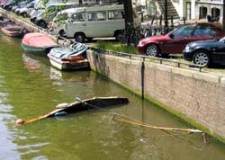
We went for breakfast to a cafe across the street called Broodje Bert's and ordered two "Ernies" for breakfast (eggs & bacon, bread, coffee & cookie, & a small salad). Bert's had been recommended by the owners of the Sunhead of 1617. After breakfast we saw a boat in the canal that was half sunk.
We had decided to follow Rick Steves "City Walk" from his Amsterdam guide, so we headed toward Dam Square. On the way we stumbled upon
the Historisch Museum's free pedestrian corridor, which is filled with Dutch group portraits. Unfortunately, the most famous of the group portraits,
Rembrandt's Night Watch, was not there (it's located in the Rijksmuseum). After that we continued up to the Dam Square.

The
Nieuwe Kerk was closed due
to renovations, so we just saw
the outside of the Nieuwe Kerk and the Royal Palace nearby. The Nieuwe Kerk, or "new church", is actually
600 years old, and is the symbolic religious center of the Netherlands, where their monarchs are crowned, wed, and buried. The Royal Palace was built
in 1652, and was originally built as a town hall. When Napoleon conquered Amsterdam, he imposed a monarchy on Holland and made his brother king, and
this building became his residence.
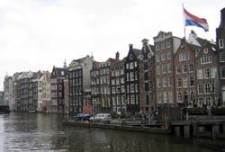
We continued north toward Centraal Station along the Damrak. Across the canal from us there was a picturesque row of buildings.
This is the most touristy part of Amsterdam. There were lots of shops selling things like t-shirts, minature windmills, faux delftware, stuff made out hemp, pipes, and other souvenirs. We walked until we reached the Damrak Sex Museum. We figured we needed a warm up for our walk through the Red Light District,
so we went in and checked out the unique exhibits.

Near the beginning of our walk through the Red Light District was the Oude Kerk. The Oude Kerk is the oldest church in Amsterdam, begun around
1300, and completed over the next 300 years. The Oude Kerk is right next to the prostitution information center in the Red Light District,
and is mostly surrounded by small windowed buildings from within which prostitutes smile out at prospective customers. In the middle of all of this
was a pre-school, the "Princess Juliana School".

We entered the Oude Kerk and saw that the World Press Photo Exhibit 2004 was being held inside. "The exhibition shows
the results of the World Press Photo contest, the largest international competition in the field of photojournalism, which [was] held for the
47th time in 2004. In February an independent international jury of experts judged tens of thousands of images and selected the winners for awards
in 20 categories." The Great Organ inside the Oude Kerk is from 1724, and is the largest in Amsterdam. Rembrandt's wife, Saskia van Uylenburgh,
is buried in the church.
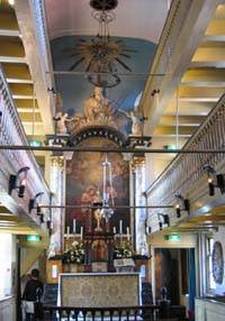
We continued along the red light district to the Amstelkring Church Museum.
When the protestant reformation reached Amsterdam, Catholic churches were outlawed, but the ban on Catholic churches was not strictly enforced.
So called "clandestine churches", whose exteriors did not look like churches, were tolerated. The
interior of the Amstelkring Church was created by joining the attics of three adjacent houses.
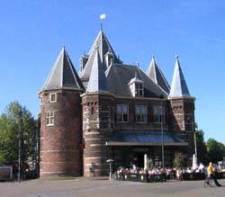
We stopped for lunch at a Thai restaurant on Zeedijk, called
"Bird Thai Restaurant." We decided to get a light meal, so only had an
appetizer, and two bowls of soup. Then we continued down Zeedijk toward de Waag. Today de Waag is a cafe, but it's served many purposes
over the course of Amsterdam's history.
De Waag was built in 1488, to serve as the main gate of the city's eastern wall. After the city expanded it was used
as a weighing house for ship's anchors and ordnance, later it served as a prison. In 1690, the octagonal tower was added so that it could
be used as the dissecting room were the Surgeons' Guild gave lessons in anatomy. Rembrandt was even commisioned to paint two anatomy lessons
that were held here. Later still it served as a fire station and two different city museums.
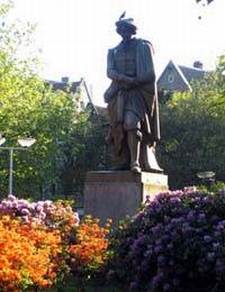
We finished Rick Steves' tour of the Red Light District, passing by the famous Casa Rosso (live sex shows). Although surrounded by similar
live sex shows, Casa Rosso is hard to miss because of it's
penis fountain with rotating balls. After leaving the Red Light District, we walked down to the Rembrandtplein, which got it's name in 1876,
when a statue of Rembrandt was erected there. Before that it had served as part of the 16th century ramparts, later it was a
buttermarket and a fairground, and currently it is a public park surrounded by bars.
By this time we had walked all over the historical core of Amsterdam, and we were exhausted. We stopped at an Indonesian place, Kantjil
to Go, and brought the food back to the Singel apartment to eat.
|

